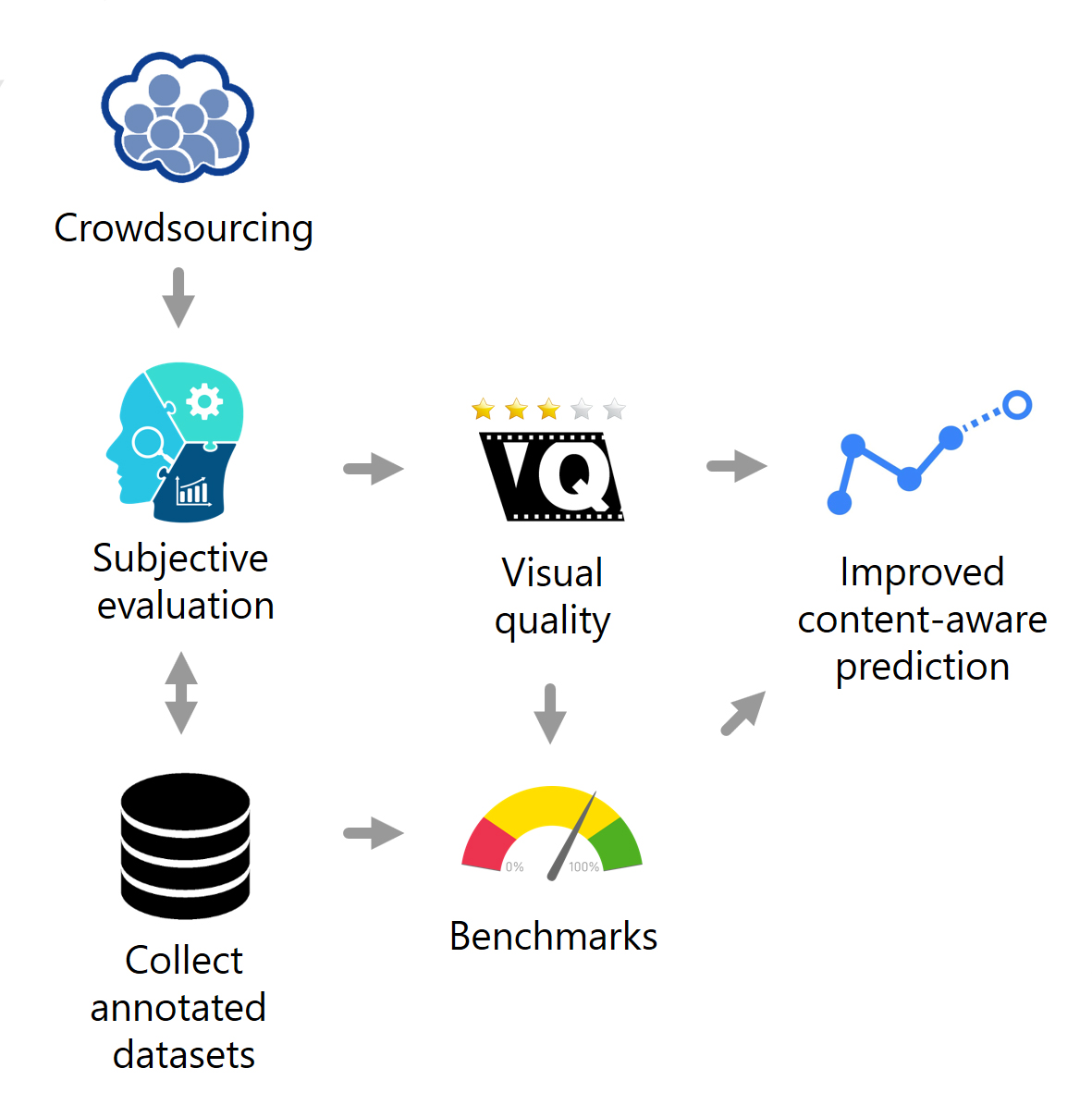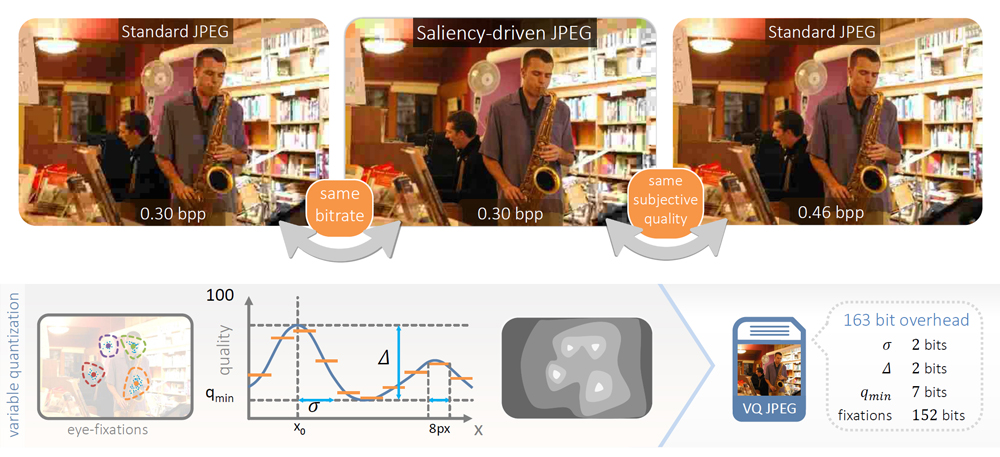A05 | Image/Video Quality Assessment: From Test Databases to Similarity-Aware and Perceptual Dynamic Metrics
The project addresses methods for automated visual quality assessment and their validation beyond mean opinion scores. We propose to enhance the methods by including similarity awareness and predicted eye movement sequences, quantifying the perceptual viewing experience, and to apply the metrics for quality-aware media processing. Moreover, we will set up and apply media databases that are diverse in content and authentic in the distortions, in contrast to current scientific data sets.
Research Questions
How can crowdsourcing be applied to help generating very large video media data bases for research applications in quality of multimedia?
What is the performance of state-of-the-art video quality assessment methods that were designed based on small training sets for such large and diversified media databases?
Quality assessment in such extremely large empirical studies requires crowdsourcing. How should that be organized to achieve sufficient reliability and efficiency?
Are machine learning techniques suitable to identify the best performing video quality assessment metrics for given media content?
What statistical/perceptual features should be extracted to express similarity for this task?
How can one design new or hybrid strategies for video quality assessment based on the above?
Can we improve methods for image/video quality assessment by studying patterns of human visual attention and other perceptual aspects?
How can knowledge on human visual attention derived from eyetracking studies be incorporated into perceptual image/video quality assessment methods?
How can the quality assessment methods be applied in quality-aware media processing such as perceptual coding?
Publications
- M. Jenadeleh, A. Heß, S. Hviid del Pin, E. Gamboa, M. Hirth, and D. Saupe, “Impact of feedback on crowdsourced visual quality assessment with paired comparisons,” in 2024 16th International Conference on Quality of Multimedia Experience (QoMEX), IEEE, Ed., IEEE, May 2024, pp. 125–131. doi: 10.1109/qomex61742.2024.10598256.
- M. Jenadeleh, R. Hamzaoui, U.-D. Reips, and D. Saupe, “Crowdsourced Estimation of Collective Just Noticeable Difference for Compressed Video with the Flicker Test and QUEST+,” IEEE Transactions on Circuits and Systems for Video Technology, p. 1, May 2024, doi: 10.1109/tcsvt.2024.3402363.
- S. Su et al., “Going the Extra Mile in Face Image Quality Assessment: A Novel Database and Model,” IEEE Transactions on Multimedia, vol. 26, pp. 2671–2685, 2024, doi: 10.1109/tmm.2023.3301276.
- M. Jenadeleh et al., “An Image Quality Dataset with Triplet Comparisons for Multi-dimensional Scaling.” IEEE, pp. 278–281, 2024. doi: 10.1109/qomex61742.2024.10598258.
- D. Saupe and S. Hviid del Pin, “National differences in image quality assessment: An investigation on three large-scale IQA datasets,” in 2024 16th International Conference on Quality of Multimedia Experience (QoMEX), IEEE, Ed., IEEE, May 2024, pp. 214–220. doi: 10.1109/qomex61742.2024.10598250.
- M. Jenadeleh, J. Zagermann, H. Reiterer, U.-D. Reips, R. Hamzaoui, and D. Saupe, “Relaxed forced choice improves performance of visual quality assessment methods,” in 2023 15th International Conference on Quality of Multimedia Experience (QoMEX), 2023, pp. 37–42. [Online]. Available: https://ieeexplore.ieee.org/abstract/document/10178467
- G. Chen, H. Lin, O. Wiedemann, and D. Saupe, “Localization of Just Noticeable Difference for Image Compression,” in 2023 15th International Conference on Quality of Multimedia Experience (QoMEX), Jun. 2023, pp. 61–66. doi: 10.1109/QoMEX58391.2023.10178653.
- M. Testolina, V. Hosu, M. Jenadeleh, D. Lazzarotto, D. Saupe, and T. Ebrahimi, “JPEG AIC-3 Dataset: Towards Defining the High Quality to Nearly Visually Lossless Quality Range,” in 15th International Conference on Quality of Multimedia Experience (QoMEX), 2023, pp. 55–60. [Online]. Available: https://ieeexplore.ieee.org/document/10178554
- O. Wiedemann, V. Hosu, S. Su, and D. Saupe, “Konx: cross-resolution image quality assessment,” Quality and User Experience, vol. 8, Art. no. 1, Aug. 2023, doi: 10.1007/s41233-023-00061-8.
- X. Zhao et al., “CUDAS: Distortion-Aware Saliency Benchmark,” IEEE Access, vol. 11, pp. 58025–58036, Jun. 2023, doi: 10.1109/access.2023.3283344.
- M. Zameshina et al., “Fairness in generative modeling: do it unsupervised!,” in Proceedings of the Genetic and Evolutionary Computation Conference Companion, ACM, Jul. 2022, pp. 320–323. doi: 10.1145/3520304.3528992.
- H. Lin et al., “Large-Scale Crowdsourced Subjective Assessment of Picturewise Just Noticeable Difference,” IEEE Transactions on Circuits and Systems for Video Technology, vol. 32, Art. no. 9, 2022, [Online]. Available: https://ieeexplore.ieee.org/document/9745537
- F. Götz-Hahn, V. Hosu, and D. Saupe, “Critical Analysis on the Reproducibility of Visual Quality Assessment Using Deep Features,” PLoS ONE, vol. 17, Art. no. 8, 2022, [Online]. Available: https://journals.plos.org/plosone/article?id=10.1371/journal.pone.0269715
- H. Lin, H. Men, Y. Yan, J. Ren, and D. Saupe, “Crowdsourced Quality Assessment of Enhanced Underwater Images - a Pilot Study,” in Proceedings of the International Conference on Quality of Multimedia Experience (QoMEX), IEEE, Sep. 2022, pp. 1–4. [Online]. Available: https://ieeexplore.ieee.org/document/9900904
- J. Lou, H. Lin, D. Marshall, D. Saupe, and H. Liu, “TranSalNet: Towards perceptually relevant visual saliency prediction,” Neurocomputing, vol. 494, pp. 455–467, 2022, [Online]. Available: https://www.sciencedirect.com/science/article/pii/S0925231222004714
- S. Su, V. Hosu, H. Lin, Y. Zhang, and D. Saupe, “KonIQ++: Boosting No-Reference Image Quality Assessment in the Wild by Jointly Predicting Image Quality and Defects,” in 32nd British Machine Vision Conference, 2021, pp. 1–12. [Online]. Available: https://www.bmvc2021-virtualconference.com/assets/papers/0868.pdf
- B. Roziere et al., “EvolGAN: Evolutionary Generative Adversarial Networks,” in Computer Vision -- ACCV 2020, Cham: Springer International Publishing, Nov. 2021, pp. 679–694. [Online]. Available: https://openaccess.thecvf.com/content/ACCV2020/html/Roziere_EvolGAN_Evolutionary_Generative_Adversarial_Networks_ACCV_2020_paper.html
- B. Roziere et al., “Tarsier: Evolving Noise Injection in Super-Resolution GANs,” in 2020 25th International Conference on Pattern Recognition (ICPR), 2021, pp. 7028–7035. [Online]. Available: https://ieeexplore.ieee.org/abstract/document/9413318
- H. Lin, G. Chen, and F. W. Siebert, “Positional Encoding: Improving Class-Imbalanced Motorcycle Helmet use Classification,” in 2021 IEEE International Conference on Image Processing (ICIP), 2021, pp. 1194–1198. [Online]. Available: https://ieeexplore.ieee.org/document/9506178
- F. Götz-Hahn, V. Hosu, H. Lin, and D. Saupe, “KonVid-150k : A Dataset for No-Reference Video Quality Assessment of Videos in-the-Wild,” IEEE Access, vol. 9, pp. 72139–72160, 2021, doi: 10.1109/ACCESS.2021.3077642.
- H. Men, H. Lin, M. Jenadeleh, and D. Saupe, “Subjective Image Quality Assessment with Boosted Triplet Comparisons,” IEEE Access, vol. 9, pp. 138939–138975, 2021, [Online]. Available: https://ieeexplore.ieee.org/abstract/document/9559922
- V. Hosu, H. Lin, T. Szirányi, and D. Saupe, “KonIQ-10k : An Ecologically Valid Database for Deep Learning of Blind Image Quality Assessment,” IEEE Transactions on Image Processing, vol. 29, pp. 4041–4056, 2020, [Online]. Available: https://ieeexplore.ieee.org/document/8968750
- H. Lin, J. D. Deng, D. Albers, and F. W. Siebert, “Helmet Use Detection of Tracked Motorcycles Using CNN-Based Multi-Task Learning,” IEEE Access, vol. 8, pp. 162073–162084, 2020, [Online]. Available: https://ieeexplore.ieee.org/abstract/document/9184871
- H. Lin, M. Jenadeleh, G. Chen, U.-D. Reips, R. Hamzaoui, and D. Saupe, “Subjective Assessment of Global Picture-Wise Just Noticeable Difference,” in Proceedings of the IEEE International Conference on Multimedia and Expo (ICME), 2020, pp. 1–6. [Online]. Available: https://ieeexplore.ieee.org/document/9106058
- O. Wiedemann and D. Saupe, “Gaze Data for Quality Assessment of Foveated Video,” in ACM Symposium on Eye Tracking Research and Applications, in ETRA ’20 Adjunct. New York, NY, USA: Association for Computing Machinery, 2020. doi: 10.1145/3379157.3391656.
- O. Wiedemann, V. Hosu, H. Lin, and D. Saupe, “Foveated Video Coding for Real-Time Streaming Applications,” in 2020 Twelfth International Conference on Quality of Multimedia Experience (QoMEX), 2020, pp. 1–6. [Online]. Available: https://ieeexplore.ieee.org/abstract/document/9123080
- H. Men, V. Hosu, H. Lin, A. Bruhn, and D. Saupe, “Subjective annotation for a frame interpolation benchmark using artefact amplification,” Quality and User Experience, vol. 5, Art. no. 1, 2020, [Online]. Available: https://link.springer.com/article/10.1007%2Fs41233-020-00037-y
- B. Roziere et al., “Evolutionary Super-Resolution,” in Proceedings of the 2020 Genetic and Evolutionary Computation Conference Companion, in GECCO ’20. New York, NY, USA: Association for Computing Machinery, 2020, pp. 151–152. doi: 10.1145/3377929.3389959.
- T. Guha et al., “ATQAM/MAST′20: Joint Workshop on Aesthetic and Technical Quality Assessment of Multimedia and Media Analytics for Societal Trends,” in Proceedings of the 28th ACM International Conference on Multimedia, in MM ’20. New York, NY, USA: Association for Computing Machinery, 2020, pp. 4758–4760. doi: 10.1145/3394171.3421895.
- X. Zhao, H. Lin, P. Guo, D. Saupe, and H. Liu, “Deep Learning VS. Traditional Algorithms for Saliency Prediction of Distorted Images,” in 2020 IEEE International Conference on Image Processing (ICIP), 2020, pp. 156–160. [Online]. Available: https://ieeexplore.ieee.org/abstract/document/9191203
- M. Lan Ha, V. Hosu, and V. Blanz, “Color Composition Similarity and Its Application in Fine-grained Similarity,” in 2020 IEEE Winter Conference on Applications of Computer Vision (WACV), Piscataway, NJ: IEEE, 2020, pp. 2548–2557. [Online]. Available: https://ieeexplore.ieee.org/document/9093522
- H. Lin et al., “SUR-FeatNet: Predicting the Satisfied User Ratio Curvefor Image Compression with Deep Feature Learning,” Quality and User Experience, vol. 5, Art. no. 1, 2020, doi: 10.1007/s41233-020-00034-1.
- H. Men, V. Hosu, H. Lin, A. Bruhn, and D. Saupe, “Visual Quality Assessment for Interpolated Slow-Motion Videos Based on a Novel Database,” in Proceedings of the International Conference on Quality of Multimedia Experience (QoMEX), 2020, pp. 1–6. [Online]. Available: https://ieeexplore.ieee.org/document/9123096/authors#authors
- V. Hosu et al., “From Technical to Aesthetics Quality Assessment and Beyond: Challenges and Potential,” in Joint Workshop on Aesthetic and Technical Quality Assessment of Multimedia and Media Analytics for Societal Trends, in ATQAM/MAST′20. New York, NY, USA: Association for Computing Machinery, 2020, pp. 19–20. doi: 10.1145/3423268.3423589.
- M. Jenadeleh, M. Pedersen, and D. Saupe, “Blind Quality Assessment of Iris Images Acquired in Visible Light for Biometric Recognition,” Sensors, vol. 20, Art. no. 5, 2020, [Online]. Available: https://www.mdpi.com/1424-8220/20/5/1308
- C. Fan et al., “SUR-Net: Predicting the Satisfied User Ratio Curve for Image Compression with Deep Learning,” in Proceedings of the International Conference on Quality of Multimedia Experience (QoMEX), IEEE, 2019, pp. 1–6. [Online]. Available: https://ieeexplore.ieee.org/document/8743204
- H. Lin, V. Hosu, and D. Saupe, “KADID-10k: A Large-scale Artificially Distorted IQA Database,” in Proceedings of the International Conference on Quality of Multimedia Experience (QoMEX), IEEE, 2019, pp. 1–3. [Online]. Available: https://ieeexplore.ieee.org/document/8743252
- H. Men, H. Lin, V. Hosu, D. Maurer, A. Bruhn, and D. Saupe, “Visual Quality Assessment for Motion Compensated Frame Interpolation,” in Proceedings of the International Conference on Quality of Multimedia Experience (QoMEX), IEEE, 2019, pp. 1–6. [Online]. Available: https://ieeexplore.ieee.org/document/8743221
- V. Hosu, B. Goldlücke, and D. Saupe, “Effective Aesthetics Prediction with Multi-level Spatially Pooled Features,” Proceedings of the IEEE Conference on Computer Vision and Pattern Recognition (CVPR), pp. 9367–9375, 2019, [Online]. Available: https://ieeexplore.ieee.org/document/8953497
- V. Hosu, H. Lin, and D. Saupe, “Expertise Screening in Crowdsourcing Image Quality,” in Proceedings of the International Conference on Quality of Multimedia Experience (QoMEX), IEEE, 2018, pp. 276–281. [Online]. Available: https://ieeexplore.ieee.org/document/8463427
- M. Jenadeleh, M. Pedersen, and D. Saupe, “Realtime Quality Assessment of Iris Biometrics Under Visible Light,” in Proceedings of the Conference on Computer Vision and Pattern Recognition (CVPRW), CVPR Workshops, IEEE, 2018, pp. 443–452. [Online]. Available: https://ieeexplore.ieee.org/document/8575548
- D. Varga, D. Saupe, and T. Szirányi, “DeepRN: A Content Preserving Deep Architecture for Blind Image Quality Assessment,” in Proceedings of the IEEE International Conference on Multimedia and Expo (ICME), IEEE, 2018, pp. 1–6. [Online]. Available: https://ieeexplore.ieee.org/document/8486528
- H. Men, H. Lin, and D. Saupe, “Spatiotemporal Feature Combination Model for No-Reference Video Quality Assessment,” in Proceedings of the International Conference on Quality of Multimedia Experience (QoMEX), IEEE, 2018, pp. 1–3. [Online]. Available: https://ieeexplore.ieee.org/document/8463426
- M. Spicker, F. Hahn, T. Lindemeier, D. Saupe, and O. Deussen, “Quantifying Visual Abstraction Quality for Stipple Drawings,” in Proceedings of the Symposium on Non-Photorealistic Animation and Rendering (NPAR), ACM, Ed., Association for Computing Machinery, 2017, pp. 8:1–8:10. doi: 10.1145/3092919.3092923.
- S. Egger-Lampl et al., “Crowdsourcing Quality of Experience Experiments,” D. Archambault, H. Purchase, and T. Hossfeld, Eds., in Information Systems and Applications, incl. Internet/Web, and HCI. , Springer International Publishing, 2017, pp. 154–190.
- U. Gadiraju et al., “Crowdsourcing Versus the Laboratory: Towards Human-centered Experiments Using the Crowd,” D. Archambault, H. Purchase, and T. Hossfeld, Eds., in Information Systems and Applications, incl. Internet/Web, and HCI. , Springer International Publishing, 2017, pp. 6–26.
- V. Hosu et al., “The Konstanz natural video database (KoNViD-1k).,” in Proceedings of the International Conference on Quality of Multimedia Experience (QoMEX), IEEE, 2017, pp. 1–6. [Online]. Available: https://ieeexplore.ieee.org/document/7965673
- V. Hosu, F. Hahn, O. Wiedemann, S.-H. Jung, and D. Saupe, “Saliency-driven Image Coding Improves Overall Perceived JPEG Quality,” in Proceedings of the Picture Coding Symposium (PCS), IEEE, 2016, pp. 1–5. [Online]. Available: https://www.uni-konstanz.de/mmsp/pubsys/publishedFiles/HoHaWi16.pdf
- I. Zingman, D. Saupe, O. A. B. Penatti, and K. Lambers, “Detection of Fragmented Rectangular Enclosures in Very High Resolution Remote Sensing Images,” IEEE Transactions on Geoscience and Remote Sensing, vol. 54, Art. no. 8, 2016, [Online]. Available: https://ieeexplore.ieee.org/document/7452408
- V. Hosu, F. Hahn, I. Zingman, and D. Saupe, “Reported Attention as a Promising Alternative to Gaze in IQA Tasks,” in Proceedings of the 5th ISCA/DEGA Workshop on Perceptual Quality of Systems (PQS 2016), 2016, pp. 117–121. [Online]. Available: https://www.isca-speech.org/archive/PQS_2016/abstracts/25.html
- D. Saupe, F. Hahn, V. Hosu, I. Zingman, M. Rana, and S. Li, “Crowd Workers Proven Useful: A Comparative Study of Subjective Video Quality Assessment,” in Proceedings of the International Conference on Quality of Multimedia Experience (QoMEX), 2016, pp. 1–2. [Online]. Available: https://www.uni-konstanz.de/mmsp/pubsys/publishedFiles/SaHaHo16.pdf
FOR SCIENTISTS
Projects
People
Publications
Graduate School
Equal Opportunity
FOR PUPILS
PRESS AND MEDIA
© SFB-TRR 161 | Quantitative Methods for Visual Computing | 2019.











